All people from Kerala(India) know the allure of this drape called”Mundum Neriyathe” or MundumVeshti or “Settum Mundum”.Although this beautiful drape which consists of two pieces of fabric ; one which is draped around the lower torso called” Munde”and the other which goes as a drape around the lower and upper torso of a woman called the”Neriyathe”, typically belongs to the Hindu religion,now a days women from all religions wear it as it is looked upon as a traditional wear of Kerala.And during a main festival of Kerala ,”Onam”, all malayali women wear it to some function over the span of these ten days .And so we can actually say that it does not anymore belong to any religion but to the beautiful women of “God’s own country”!
This is such a beautiful dress and will actually appeal to anyone around the world who loves drapes as this is typically in a offwhite colour with Gold Zari border which looks extremely classy and has an aura of royalty. Any woman wearing this dress has a beauty of her own and looks complete with generally some gold jewellery and jasmine flowers on her hair and a red “bindi”(round spot) on her forehead.
The typical ” Mundum Neriyathe” comes in Off white and a flat gold Zari border called “Kasavu”, or the border will be in a flat colour or stripe called “Kara”and was always woven.But as in any other dress , this drape also has evolved over the ages and now a days come in all sorts of designs. The main change happens with the border mainly; it has gone from printed to embroidered to attached brocade borders. And the “Zari” also has changed from Gold to Silver or a mix of both. The body essentially remains off-white. But now a days, experiment is happening with the colour of the body too. And typically this drape is found in Cotton only ; but now a days it is done in Silk as well ,due to demand for a more expensive look for weddings.
This drape is used by a lot of Hindus for a part of their weddings. Both the traditional and modern styles of the mundum neryathum are depicted in the paintings of the Indian painter Raja Ravi Verma. In olden times,the attire was worn with the “Neriyathu”wrapped around the bust and also a blouse was not worn . Women of Kerala also wear the drape for a traditional folk dance called “ Kaikottikalli” and “Thiruvathirakali”.
I have always been fascinated with this drape from a very young age. The best image that has been stuck in my mind is of my mother wearing this drape in the mornings after her bath and with “Sindooram on her forehead on her hair parting ! She would even wear a basal leaf on her long hair which sort of completed the look( both practices being done by Hindu women of this region). When I woke up in the mornings ,it was such a positive image to see…..for me she looked so beautiful like a goddess of love! And yes she was one, in her nature too.
I grew up having this fascination for the drape and till date it is more alluring to me than a “sari”! I feel it is more sensual in look and very feminine too. It is extremely simple to drape it unlike the “Sari”! And thus convenient to move about as well as airy and breathable in the humid climate of Kerala.
When I talk about Mundum Neriyathe , another drape which comes to my mind and which has struck me is “Meghela Chador of Assam”. I came across this drape accidentally through a friend who was assamese and I saw her wearing this for my brother’s wedding. I was really surprised to see something so similar to our own drape of Kerala. Then I really got to know about this drape.There are two main pieces of cloth that are draped around the body. The bottom portion, draped from the waist downwards is called the mekhela (Assamese: মেখেলা). It is in the form of a sarong—very wide cylinder of cloth—that is folded into pleats to fit around the waist and tucked in. The folds are to the right, as opposed to the pleats in the Nivi style of the saree, which are folded to the left.The top portion of the two-piece dress, called the chador, is a long length of cloth that has one end tucked into the upper portion of the Mekhela and the rest draped over and around the rest of the body.
Ornamental designs on the Mekhela chadors are traditionally woven, never printed. Sometimes a woven pattern, called the pari is stitched along the sides of a chador, or along the bottom of a mekhela. These drapes come in Cotton as well silk traditionally but now a day are also produced as blends of Cotton and Silk with Synthetic Fabrics.
I saw a huge collection of these beautiful drapes in my friend’s collection. And there is even an antique one which her grandma had woven by herself and handed it down. And surprisingly for their weddings also just like in Kerala , they wear the traditional colour of off-white and Gold. I was flabbergasted; how can two regions so far away from each other have the same kind of drape and follow the same colour scheme? Such is life!…..I conclude.
For folks around the world who would like to see how a “Mundum Neriyathum ” is draped, here it is.
For folks who are interested to watch how a “Mekhala Chador” is worn, here it is.
Courtesy: Sameera Dipshikha Dowerah

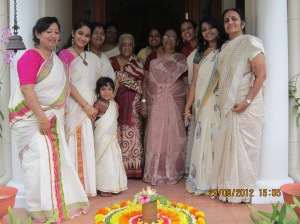
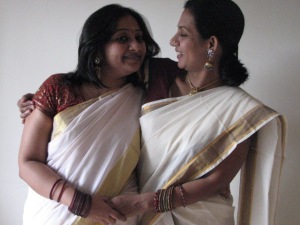
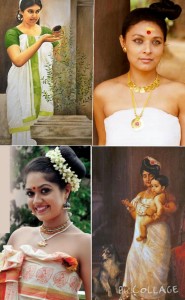
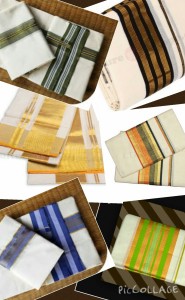
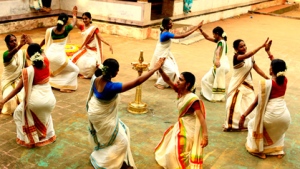
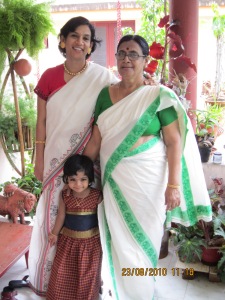
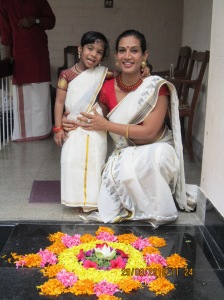
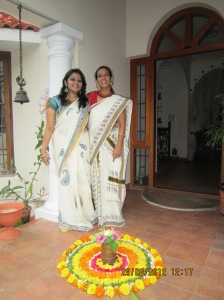
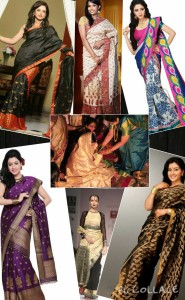
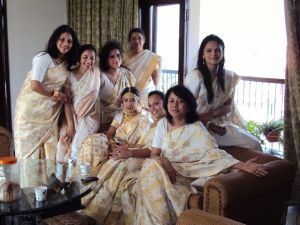

Well done Arch.. You have done a great job by educating people who doesn’t about this attractive garments. These are easily worn garments..no headaches with zips, buttons or laces, just tie it in knots..
Keep writing
LikeLiked by 1 person